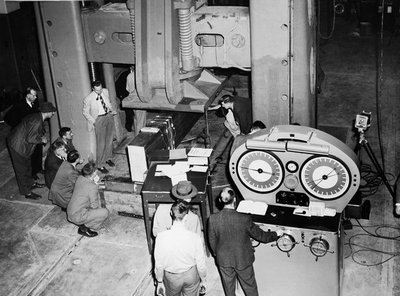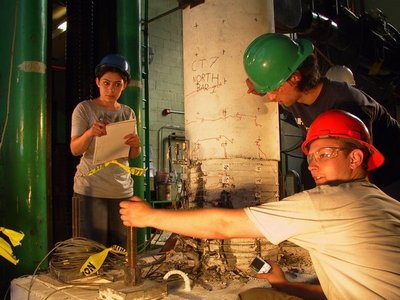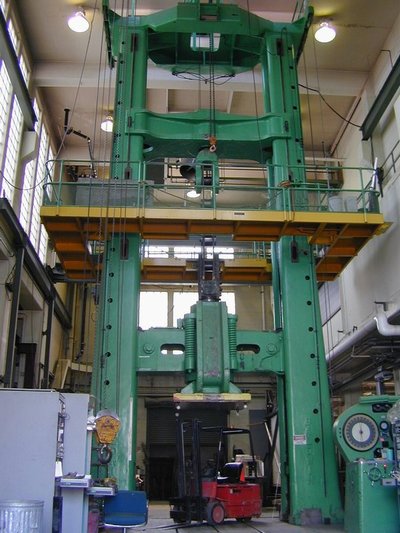September 19, 2007
Collapsing structures to be tested in revamped UW engineering lab
Just as Minneapolis now finds itself in the middle of a national debate on bridge safety, so the Puget Sound area was some 70 years ago. The infamous collapse of the Tacoma Narrows Bridge in 1940 prompted a national discussion on bridge engineering. It also provided the impetus for founding University of Washington’s Structural Research Laboratory, which opened its doors in 1948 in the school’s department of civil and environmental engineering.
Through the decades, engineers at the UW built a national reputation for researching the safety of large-scale infrastructure such as piers, bridges and buildings. This August, the lab received a $557,870 grant from the National Science Foundation to augment its central equipment and prepare for modern challenges.
The money will be used to add features to the lab’s central piece of equipment, dubbed “the Baldwin,” and related machinery. The Baldwin pushes down with as much as 2.4 million pounds of pressure on piers, support beams, trestles or other critical components of engineering infrastructure. Related equipment simulates other dynamic loads on a structure, such as earthquake, wind and blast, at the same time. In this laboratory, breaking things to better understand them is the goal. The UW’s lab is one of the few in the country that has the capacity to take components all the way to failure. The new grant will allow the Baldwin to simulate real-time collapse.
“Most labs can’t take a structure completely to collapse because you have to be able to handle a large load and be able to control that load very precisely,” said lab director Dawn Lehman, a UW assistant professor of civil and environmental engineering. One of the changes will allow experiments to change the load electronically, rather than manually, in order to vary the load as fast as 10 times per second. Other enhancements will use laser sensors to monitor the component’s behavior without having to use a device that actually touches the system.
As a structure begins to fail it shifts the load to different parts of the structure, and sudden caving in poses risks to human life. Researchers will record the performance of infrastructure and then use the measurements in computer simulations. The device can test components as large as 25 feet tall.
“We’ve found in recent earthquakes that people made misleading decisions based on small-scale tests,” said Charles Roeder, a UW professor of civil and environmental engineering and expert on bridge construction. “We’re doing bigger and bigger tests. It’s more expensive, but it gives you better data.”
The upgrade will be complete by 2009. Meanwhile other tests will continue.
Historical photographs from the early 1950s show engineers working in the lab sporting Homburg hats and smoking pipes. The 40-foot-tall Baldwin originally traveled to campus on a railway car. Once it was in place, the lab was built around it.
Although fashions have changed, the need to test crucial infrastructure has not gone away. A number of high-profile events in recent years — including the World Trade Center’s collapse in 2001, the destruction of the federal building in Oklahoma City, and ongoing concerns about terrorist attacks — prompted the request to add modern features to the lab’s biggest piece of equipment. The recent failure of the Interstate 35W bridge in Minneapolis raised new questions about the safety of aging bridges across the nation.
The structures laboratory is currently researching a wide range of issues, including gusset plate connections for braced frames, rapid construction methods for bridges, concrete-filled bridge piers, and lightweight bridge-deck replacements.
By observing the collapse and comparing different materials’ performance, the engineers hope that even in a worst-case scenario the structure would be less likely to break. An older reinforced concrete building is 10 times more likely to fail than a new one, Lehman noted. This suggests that construction methods have a profound impact on safety.
The researchers hope to discover further improvements. Most of the tests are not on specific roads or on bridges. Instead, they compare designs that would have broad application to the construction and engineering communities.
“Eventually, we’re going to break something,” Roeder said of the tests, which start by gradually stressing the system and then crank up the pressure until something gives. “The question is what breaks, and how quickly.”
###
For more information, contact Lehman at (206) 715-2108 or delehman@u.washington.edu and Roeder at (206) 543-6199 or croeder@u.washington.edu.
Reporters, photographers and camera crews are welcome to attend one of the experiments. Contact the researchers to find out about the test schedule.



